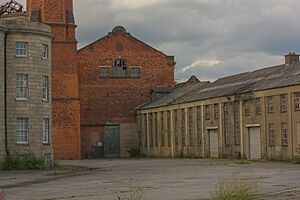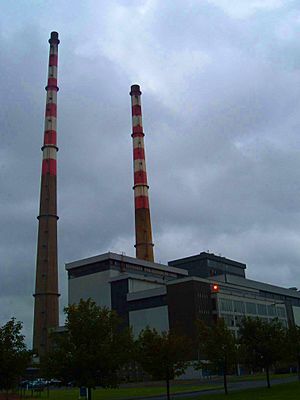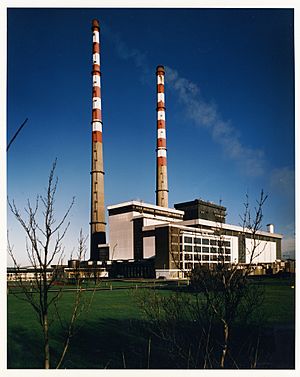Poolbeg Generating Station facts for kids
Quick facts for kids Poolbeg Generating Station |
|
|---|---|

Poolbeg Power Station in Dublin, Ireland
|
|
| Country | Ireland |
| Location | Dublin |
| Coordinates | 53°20′23″N 6°11′23″W / 53.3396047°N 6.189821°W |
| Status | Decommissioned |
| Construction began | 1965 |
| Decommission date | 2010 |
| Construction cost | IR£60 million |
| Operator(s) | Electricity Supply Board (ESB) |
The Poolbeg Generating Station (also known as The Poolbeg Stacks) is a big power plant in Ireland. It used to make electricity and was run by the Electricity Supply Board (ESB).
There are two main parts to the station. One part was an older "thermal" station. The other part was a newer "combined cycle" gas station. Together, these parts could make a lot of electricity – about 1020 MW.
The power station is on a special piece of land called the Poolbeg peninsula. This land was actually made by humans, using material dug up from the sea. It's in Dublin, near Dublin Port. Its two tall chimneys are over 207 meters high! They are easy to spot from most of Dublin and are some of the tallest structures in Ireland.
Contents
History of Poolbeg Power
The Poolbeg power station is right next to an older power station called the Pigeon House. Electricity was first made there in 1903. It was special because it was the first in the world to make a certain type of electricity called "three-phase power."
The name "Pigeon House" comes from a small building built in 1760. This building was for a caretaker named John Pidgeon. He opened a place to eat for workers and travelers. It became a very popular restaurant in Dublin.
Later, around 1793, a hotel opened there. But after a rebellion in 1798, the area became a military fort. The hotel building was turned into rooms for army officers. Over the next 100 years, the fort grew to include an armory (for weapons) and a hospital.
In the late 1800s, the military fort was sold. It was turned into a sewage treatment plant and Dublin's first big electricity power station. The Pigeon House power station was used until 1976. Even today, the Poolbeg plant is sometimes called "the Pigeon House" by local people.
The modern Poolbeg station got its name from the Poolbeg lighthouse. This lighthouse was built in 1767. It stood at the edge of a natural pool of water at the entrance to Dublin Harbor. This pool was called "Poole Begge."
The Poolbeg power station was built in two main stages. The first part was finished in 1971. This included Units 1 and 2. Unit 3 was added in 1978. The newer gas station parts (CG14, CG15, and ST16) were built in the 1990s and early 2000s.
How Poolbeg Made Power
The older parts of the station, Units 1 and 2, could each make 120 MW of power. Unit 3 was bigger, able to make 271 MW. These units could use either oil or natural gas to create electricity. The oil was kept in huge tanks on the site.
The newer "combined cycle" plant used gas turbines. It also used a special system to capture heat and make more electricity. Since 2017, a nearby facility that turns waste into energy has also supplied steam to the power plant.
When Poolbeg Closed Down
In 2006, the ESB decided to close some older power stations in Ireland. This was because they were not as efficient. The older thermal units at Poolbeg, which made about 461 MW of power, were planned to close. They officially stopped working in 2010. However, the newer gas turbine part of Poolbeg stayed open.
The Famous Poolbeg Chimneys
The two chimneys of the thermal station were finished in 1971. They are among the tallest structures in Ireland. You can see them from almost anywhere in Dublin city. One chimney is about 207.48 meters tall, and the other is 207.8 meters tall.
These chimneys are so famous that they even appeared in the music video for the song "Pride (In The Name Of Love)" by the band U2. When the station was going to close in 2010, many people wanted to protect the chimneys. They are now officially listed as "protected structures" since July 2014, which means they cannot be easily changed or removed.




